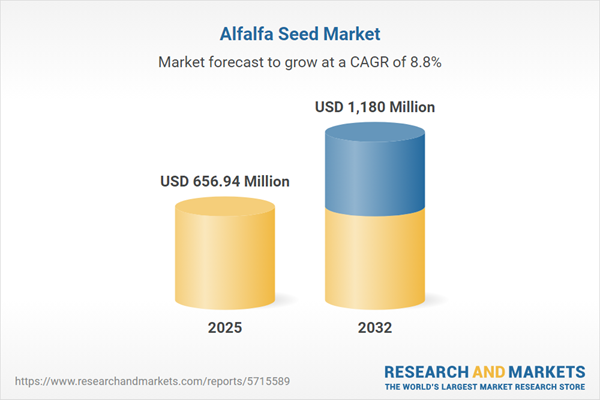Speak directly to the analyst to clarify any post sales queries you may have.
Senior executives navigating the alfalfa seed market are responding to transformative pressures as sustainability standards, evolving compliance mandates, and the adoption of new technologies reshape procurement frameworks. In this rapidly developing environment, agility and forward-thinking strategies are crucial for building resilient, growth-oriented operations.
Market Snapshot: Alfalfa Seed Market Size and Growth
The global alfalfa seed market reached a value of USD 602.66 million in 2024 and is projected to grow to USD 656.94 million by 2025. Long-term forecasts indicate expansion, with the market expected to achieve USD 1.18 billion by 2032, reflecting a compound annual growth rate (CAGR) of 8.81%. Driving this growth are increased global demand for high-protein livestock feeds, wider adoption of genetic engineering in crop production, and an elevated reliance on advanced seed treatment solutions. Procurement stakeholders are recalibrating their risk management and business continuity practices to address mounting uncertainties from climate volatility, prioritizing resilient supply chain strategies and enhanced seed technologies to mitigate disruptions.
Scope & Segmentation of the Alfalfa Seed Market
- Type: Both conventional and organic alfalfa seeds meet business needs for environmental stewardship, aligning with varied global regulatory standards for production and trade.
- Crop Type: Used for hay, pellets, silage, and sprouts, these seeds facilitate targeted livestock nutrition programs and support a range of enterprise sizes and agricultural models.
- Distribution Channel: Traditional offline sources and digital procurement platforms offer organizations flexibility in sourcing, transparency, and the ability to control supply chain costs.
- Application: Primary roles include providing animal feed and forage, while also contributing to biofuel production and soil health initiatives that underpin sustainable operations.
- Seed Treatment: Choices between treated and untreated seed varieties allow tailoring to specific crop health protocols, accommodating both organic and conventional cultivation requirements.
- Regional Coverage: The market spans the Americas, Europe, Middle East & Africa, and Asia-Pacific, where producers and buyers contend with unique climate profiles and policy conditions in countries such as the United States, Canada, China, India, and Australia.
- Key Companies Profiled: The industry features established benchmarks set by major suppliers, including DLF A/S, Barenbrug International B.V., Corteva Agriscience (Pioneer Hi-Bred International, Inc.), Land O'Lakes, Inc., Nutrien Ltd., AgReliant Genetics, LLC, Allied Seed, LLC, Forage Genetics International, LLC, CircleSeed, LLC, and S&W Seed Company.
Key Takeaways for Senior Decision-Makers
- Strategic alfalfa seed selection underpins regenerative agriculture programs, advancing sustainable and robust supply chains that withstand unpredictable disruptions.
- Implementation of genomic innovations and enhanced seed treatment technology help organizations address shifting compliance requirements and maintain productive, adaptable operations.
- Procurement strategies emphasize improved traceability and organic compliance, allowing businesses to meet responsible sourcing standards globally.
- Digital procurement tools empower real-time monitoring of supply networks, fostering agile, evidence-based decision-making across diverse operating environments.
- Regionally tailored seed solutions and sourcing flexibility assist enterprises in managing trade exposures and sustaining continuity under dynamic market conditions.
- Adapting seed strategies to local regulatory and climatic contexts enables firms to respond effectively to emerging policy and weather-related challenges across core regions.
Tariff Impact: United States Trade Measures on Alfalfa Seed Supply Chains
Recent adjustments in United States tariff policies are reinforcing the significance of local sourcing and deeply rooted supplier relationships. These developments require ongoing risk assessment and adaptive scenario planning, especially for organizations with cross-border supply chains. Flexible procurement approaches are increasingly necessary to respond to potential market shifts caused by policy changes.
Methodology & Data Sources
Analysis is based on direct interviews with alfalfa breeders, distributors, and high-volume buyers, complemented by targeted industry surveys and comprehensive regulatory assessments. The report incorporates findings from both proprietary and peer-reviewed data sources to ensure executive-level relevance and accuracy.
Why This Report Matters
- Enables decision-makers to identify supply chain risks and seize market opportunities to drive efficiency and foster sustainable growth within the alfalfa seed value chain.
- Provides actionable segmentation and compliance recommendations for shaping product expansion and technology investments across diverse regional markets.
- Supports integration of current regulatory and technological advances into procurement and operational strategies for improved business outcomes.
Conclusion
Adapting to sustainability mandates, regulatory change, and technological advancements is essential for maintaining competitive strength and resilience in the alfalfa seed market. Ongoing market monitoring supports both strategic growth and operational stability.
Additional Product Information:
- Purchase of this report includes 1 year online access with quarterly updates.
- This report can be updated on request. Please contact our Customer Experience team using the Ask a Question widget on our website.
Table of Contents
3. Executive Summary
4. Market Overview
7. Cumulative Impact of Artificial Intelligence 2025
Companies Mentioned
The companies profiled in this Alfalfa Seed market report include:- DLF A/S
- Barenbrug International B.V.
- Corteva Agriscience (Pioneer Hi-Bred International, Inc.)
- Land O'Lakes, Inc.
- Nutrien Ltd.
- AgReliant Genetics, LLC
- Allied Seed, LLC
- Forage Genetics International, LLC
- CircleSeed, LLC
- S&W Seed Company
Table Information
| Report Attribute | Details |
|---|---|
| No. of Pages | 199 |
| Published | November 2025 |
| Forecast Period | 2025 - 2032 |
| Estimated Market Value ( USD | $ 656.94 Million |
| Forecasted Market Value ( USD | $ 1180 Million |
| Compound Annual Growth Rate | 8.8% |
| Regions Covered | Global |
| No. of Companies Mentioned | 11 |









